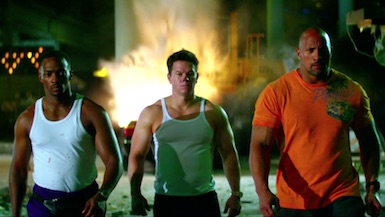The Number One Movie in America: Pain & Gain
By Sean Collier
April 8, 2020
Michael Bay doesn’t generally make unsuccessful movies.
All of his films have been profitable, some staggeringly so. His debut feature as a director, 1995’s “Bad Boys,” pulled in a global tally north of $141 million on a $19 million dollar budget; two “Transformers” films, 2011’s “Dark of the Moon” and 2014’s “Age of Extinction,” crossed the billion-dollar mark at the global box office.
He also doesn’t make cheap movies. Only four pictures in his filmography were completed for less than $100 million; even more humble successes (a relative term in this case) such as “The Island” ($126 million budget, $162.9 million global gross) and “Pearl Harbor” ($140 million budget, $449.2 million global gross) have cost an amount that could finance several dozen Blumhouse horror features.
Just about the only blemishes on Bay’s balance sheet are mid-’10s passion projects. “13 Hours,” one of the only films to have an Oscar nomination rescinded, only pulled in $62 million worldwide. And “Pain & Gain,” a tonally bizarre crime caper by way of a love letter to ’90s Floridian machismo, fell short of $100 million at the global box office. Domestically, it pulled just under $50 million — the smallest figure of any picture directed by the bombastic action king.
It was still a modest success. Its budget was a mere $26 million — Bay and stars Mark Wahlberg and Dwayne Johnson chose to skip a salary in favor of back-end earnings which failed to materialize — and it was a one-weekend champ, briefly claiming the title with $20.2 million from April 26-28, 2013, turning a smattering of heads before it was obliterated by the release of “Iron Man 3” the following week.
It’s not hard to understand why “Pain & Gain” didn’t resonate. A true-crime tale oddly reconstructed as a violent-yet-wacky caper, the film follows a trio of South Beach lunkheads — Wahlberg, Johnson and Anthony Mackie — as they attempt to extort a small-time bigwig played by Tony Shalhoub. It has genuine moments of comedy, which are swiftly undercut by off-putting violence. It has nuanced performances, particularly by Mackie and Ed Harris, which are neutralized by the presence of an unlikeable-by-design Wahlberg in nearly every scene.
“Pain & Gain” was a long-simmering project Bay kept pushing as a break from his string of “Transformers” moneymakers. He attempts to flex his artistic side with dramatic composition and “Scarface”-meets-“Miami Vice” style, with middling results. Some sequences work as intended; others miss the mark by miles.
It’s not strictly a bad movie, but it is certainly not a good one.
Bay’s oeuvre is not without merit; “The Rock” is a perfectly serviceable boulder of late-century hyperaction, and even the bloated “Armageddon” has merit as the sort of summer spectacle readymade for a drive-in cinema. But projects like “Pain & Gain” expose whatever weakness remain hidden by the director’s more popcorn-friendly fare. This is a guy that knows his way around robots in disguise and gargantuan pyrotechnics — but not human motivation.
“Pain & Gain” is the subject of the latest episode of The Number One Movie in America, a look back at past box-office champions. Each episode’s film is drawn at random from a list of every number-one movie since 1982. Please listen and subscribe!
Next time: Hey! Teacher! Leave them kids alone! Actually, help them, they need guidance..




